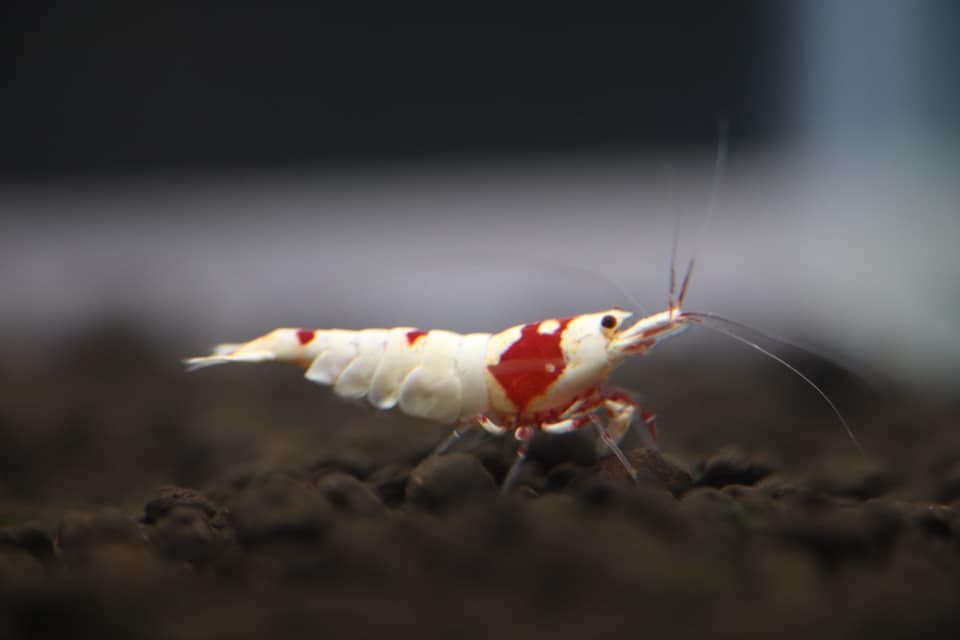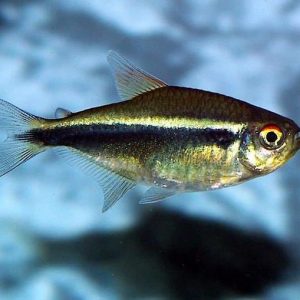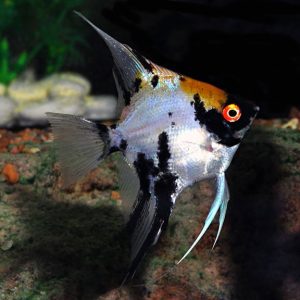Pure Line Red Crystal Shrimp
Pureline Red Crystal Shrimp, also known as Pure Red Line (PRL) shrimp, are a refined variant of the Crystal Red shrimp. They are the result of selective breeding aimed at maintaining their pristine heritage. Here are some key points about them:
-
Appearance: PRL shrimp have predominantly opaque white bodies with red spots and patterns, such as crowns, smiles, or flowers. Unlike typical Crystal Red shrimp, they don’t have full red bands.
-
Size: They are tiny, usually growing to about 2-3 cm (30 mm) in size.
-
Habitat: Ideal for nano aquariums and aquascapes, they help keep the environment clean by grazing on organic matter and algae.
-
Care: They require specific water parameters (GH: 5.5-6.5, KH: 0-2, TDS: 100-180, Temperature: 20-22°C). They also need slow drip acclimation when introduced to a new tank.
-
Compatibility: They should not be kept with all fish, only with compatible micro varieties.
-
Breeding: PRL shrimp are easy to breed and will not produce any white offspring.
Would you like to know more about their care or breeding?
د.إ25.00
The pure red line shrimp have a predominantly white body that is opaque. Unlike the crystal red shrimp they barely have full red bands. The red spots on the head can even have certain patterns, like a crown, smiley, or flower. These shrimp are unique in that they won’t produce any white offspring.
Care
The most important for any aquatic species in an aquarium is having a cycled aquarium. If you don’t know what this is, you should read How to cycle a shrimp aquarium before continuing.
Even though shrimps have a low bioload it is still important to provide adequate filtration. Sponge filters are the most commonly used as a filter. Other options are a ‘hang-on-the-back’ filter and canister filters. These last ones can also be used if the filter’s inlet is protected from sucking up any (baby) shrimp. For C. cantonensis species an under-gravel filter (UGF) is also recently becoming a popular choice because it can help save soil costs.
Water Parameters
Crystal shrimp need their water to be more acidic with a low GH (general hardness) and a very low, to no, KH (carbonate hardness). Generally these parameters are almost impossible to achieve with normal tap water, which is why you need to use reverse osmosis (RO) water. There are special remineralisers on the market, like Shrimp King’s bee salt GH+ and Salty Shrimp’s Bee shrimp mineral GH+, that are used to get the correct GH value. It is important to have a product that only increases the GH of the water, not the KH. Crystal shrimp don’t tolerate a lot of dissolved calcium and magnesium because it is harmful to their molting process. Therefore make sure you have the right product.
Given their preference for acidic water and need for a low KH it is crucial to have a buffering soil. This soil will take over this stabilising role and actively help with keeping the pH and KH low. But don’t forget to renew the substrate after some time in use.
Equally as important is the temperature. Since they come from river streams they prefer a bit colder water than most tropical species. They thrive well in water between 20°C and 22°C.
It’s very important to keep your water parameters very stable!
Tank Size
Following their need for stable water parameters, it’s advised to go with a bigger aquarium so that the conditions as consistent as possible. As a result the minimum tank size for a group of pure red line shrimp is 30 L (8 gallons). The stocking density has been shown to be more optimal with 2-4 adult shrimp per 1 litre (0,26 gallons) of water.
Habitat
While these shrimp can breed and thrive in a bare substrate aquarium, it is always better to keep in mind their original habitat has several natural hiding spaces. It’s important to remember that shrimp are still prey animals and can have higher stress levels if they cannot have access to hiding spaces.
When shrimp molt it takes a while for their new shell to harden, so they are very vulnerable and like to hide during this time. Thus a planted tank is preferred as the plants provide shelter, lots of surface area for biofilm to grow, and they also help with keeping the water parameters stable by absorbing some of the produced nitrates.
Diet
Pure red line shrimp are, like all Caridina shrimp, omnivores and will eat almost anything, including other dead shrimp or fish. They generally love to eat biofilm and algae which are naturally occurring in an aquarium. However, this isn’t enough food, and needs to be supplemented for your colony to thrive.
If a vibrant red colour is important to you, it’s advised to supplement the food with a source of carotenoids. These are pigment molecules that are responsible for the bright red and orange colours. The nutrient is also important for the development and function of the shrimp’s immune system and reproductive system.
Some good options include carrots, sweet potatoes, and pumpkins, which can be blanched and offered to the shrimp as a treat. If you buy your food, check the ingredient list of the food to see if they have added the supplement ‘astaxanthin’.
Overall, it is important to provide a varied and nutritionally balanced diet to insure their health and well-being.
Tank Mates
Generally, anything that can live in the same water parameters can be a tank mate. But be careful if you want to breed with your shrimp. Some fish love to have a baby shrimp as a treat! A rule of thumb is that if a fish’s mouth is big enough to fit a baby shrimp (shrimplet) or even an adult shrimp, it will probably eat it.
Most fishes’ diet includes crustaceans and that means our beloved shrimp are part of their menu. But shrimp and fish can certainly be tank mates, if you choose small non-aggressive fish like Chili Rasbora, Ember tetra and Neon tetras. Also provide a lot of hiding spaces so your shrimps feel safe.
Keeping other Caridina cantonensis together with PRL will result in crossbreeds like Tibees. This will in turn dilute their line and not make them “pure” anymore.
Snails are a great addition to a shrimp tank as they will eat any leftover food, but be careful as some species will overpopulate if you overfeed!
Breeding
It is highly advisable to not keep any other fish in the aquarium if you want to breed. Other than keeping the water parameters stable your shrimps do not have any extra needs in order for them to breed. It is best to start with a group of at the minimum 10 but preferably 20 or more, the bigger the starting group the lower the chances of inbreeding and genetic defects to occur. Equally important is having a good male-to-female ratio in your shrimp tank, the ideal ratio is 3 females for every male shrimp.
A berried shrimp (a female carrying fertilised eggs) will carry between 20 to 30 eggs that she will fan between her pleopods to provide them with fresh oxygenated water and keep them clean. After about 25-35 days the eggs will hatch, unlike the Amano shrimp, C. cantonensis don’t have a larval stage. The baby shrimp, also called shrimplets, will look like a tiny copy of its parents.
Related products
-
LIVE FISH, FANCY, KOI
Koi Angel
0 out of 5(0)We make sure all our fishes are kept with highest living standards with proper aquarium water care. Our fishes are quarantined before they are introduced to the store display aquariums. We make sure we sell healthy live fish and not parasites.
NOTE: OUR LIVE FISHES ARE ONLY DELIVERED TO DUBAI AND SHARJAH.
CUSTOMERS FROM ABUDHABI AND OTHER EMIRATE MAY CONTACT US TO
SKU: n/a -
LIVE FISH, BETTA
Super Blue Half Moon Betta
0 out of 5(0)We make sure all our fishes are kept with highest living standards with proper aquarium water care. Our fishes are quarantined before they are introduced to the store display aquariums. We make sure we sell healthy live fish and not parasites.
NOTE: OUR LIVE FISHES ARE ONLY DELIVERED TO DUBAI AND SHARJAH.
CUSTOMERS FROM ABUDHABI AND OTHER EMIRATE MAY CONTACT US TO
SKU: n/a -
LIVE FISH, Guppy
FEMALE GUPPY RED
0 out of 5(0)We make sure all our fishes are kept with highest living standards with proper aquarium water care. Our fishes are quarantined before they are introduced to the store display aquariums. We make sure we sell healthy live fish and not parasites.
NOTE: OUR LIVE FISHES ARE ONLY DELIVERED TO DUBAI AND SHARJAH.
CUSTOMERS FROM ABUDHABI AND OTHER EMIRATE MAY CONTACT US TO INQUIRE
SKU: n/a






